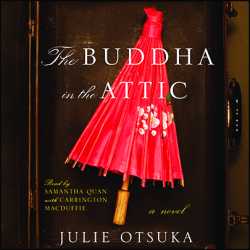The saga of the Japanese “picture brides” who came from Japan to California after World War I is a sad chapter of American history that is unfamiliar to many of us. More of us know a little about the later internment of these women and their families, along with other Japanese Americans, during World War II, but we may have thought little about how wrenching that experience was. Julie Otsuka, a native Californian, has given those women voice through her moving little book, The Buddha in the Attic. I listened to those voices on the audio version of the book, and they also come through clearly in Otsuka’s haunting prose in the print version.
By Linda Brinson
THE BUDDHA IN THE ATTIC. By Julie Otsuka. Random House Audio. Four hours; four compact discs. Read by Samantha Quan and Carrington MacDuffie. $30. Also available in print from Knopf. 129 pages. $22, hardback.
 These are the stories of the Japanese “picture brides,” young women who left everyone they loved and everything they knew in Japan not long after World War I. They sailed to the United States on the strength of a promise and a photo of a man they did not know, a man whom they would marry as soon as they arrived. Many landed in California only to find that both the photo and the story of success that accompanied it were shams.
These are the stories of the Japanese “picture brides,” young women who left everyone they loved and everything they knew in Japan not long after World War I. They sailed to the United States on the strength of a promise and a photo of a man they did not know, a man whom they would marry as soon as they arrived. Many landed in California only to find that both the photo and the story of success that accompanied it were shams.
Some were lucky, finding considerate men with whom they eventually built a good life and perhaps even loved. Others were treated brutally. Many found themselves slaving alongside their husband as migrant laborers at California’s farms and vineyards, where Japanese were prized as hard workers. Others became domestic laborers in fine homes in California’s cities. Most struggled to feel at home in the strange land where they would live out their lives. Soon they had children, who grew up without knowing or valuing the old ways to which the women had tried to cling. And just when they were beginning to settle into some kind of acceptable life, Japan attacked Pearl Harbor, and they were rounded up and marched away because their American neighbors feared that any Japanese was an enemy, a spy or a potential murderer in the night.
Julie Otsuka, who won acclaim for her first novel, When the Emperor Was Divine, has obviously done extensive historical research. Part of her gift is to make that history come alive, to translate dry fact into immediate, heartfelt and heart-rending stories.
The word “incantatory” is often aptly used to describe Otsuka’s prose. So are “poetry” and “Greek chorus.” I can imagine a stage production of The Buddha in the Attic, with a succession of kimono-clad actresses reciting some of the book’s passages.
Otsuka calls this book a novel, but it is really something else, something that transcends familiar categories. The stories she tells are fiction grounded thoroughly in reality. But rather than take three or four of the picture brides and develop their characters and stories fully, as a more conventional novelist might do, she tells many, many stories, often using the pronouns “we” and “us,” only occasionally offering “Asako” or “Yuriko” or some other name. A few individual stories go on for paragraphs; many are told in a sentence or part of a sentence.
The effect is of a large chorus of Japanese women crying out their stories in turn. The books is moving and deeply affecting. Anyone who reads it or listens to it will never again be able to ignore this part of our history.
I found the audio book, capably read by Samantha Quan and Carrington MacDuffie, fascinating, often sad, occasionally humorous and always moving. I did not, however, feel the need to keep driving if I reached my destination before the end of the CD to which I was listening. I suspect that I would have had a similar reaction to the print version: I would have been able to set the book down and return to it later, as I might a volume of poetry, rather than feeling compelled to read into the night.
In other words, prospective listeners and readers should be aware that although it’s called a novel, The Buddha in the Attic is not a book that will give you characters you come to know as if they were alive, and a story that draws you deeply into those characters’ lives. This book is something else altogether, yet something unforgettable and worthwhile, a beautiful work of art.